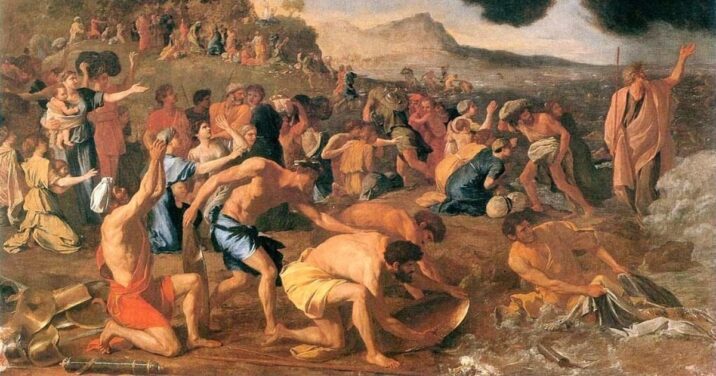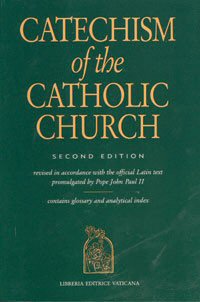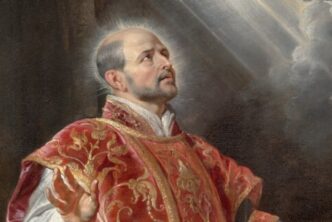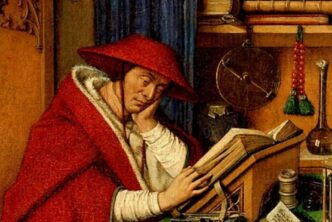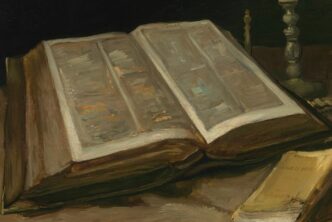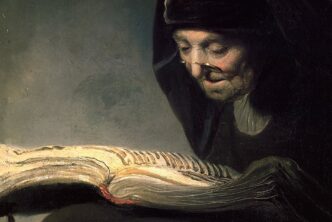As the season of Lent gets underway, many Catholics understandably look for a concrete plan for their prayer life to complement their disciplines of fasting and almsgiving. Some will work their way through one of the great spiritual classics, such as St. Augustine’s Confessions or St. Ignatius of Loyola’s Spiritual Exercises. Others may adopt a more literary approach by prayerfully reading through Dante’s Purgatorio. And still others will observe a Catholic Lenten Bible study and accompany Christ in the desert by meditating daily on God’s Word.
To those in the latter camp, I would like to propose that the book of Exodus is particularly well-suited for Catholic Lenten Bible study. And not only because it has exactly forty chapters, one for each day of Lent.
To that end, I would like to offer seven (more substantive) reasons for taking up and praying your way through the book of Exodus during Lent.
- The Church gives Exodus as Lenten reading in the Divine Office
- The Apostle teaches that these events were “examples for us”
- Christ fulfills the Exodus
- Exodus reveals the character of God
- Moses is a figure of Christ the Mediator
- The Lord desires our freedom
- Exodus reveals our pilgrimage to God
- Conclusion
1. The Divine Office already commends readings of the Exodus
For those who pray the Liturgy of the Hours, the book of Exodus is already part of the first few weeks of Lenten devotion. After a jumpstart in Isaiah 58 on Ash Wednesday, the biblical (first) reading of the Office of Readings works sequentially through a substantial amount of Exodus for the next twenty-four days—through the Saturday of the third week of Lent. (This is followed by select excerpts from Leviticus and Numbers in week four of Lent, and then a substantial reading of the letter to the Hebrews from the Fifth Sunday of Lent up until Holy Thursday.)1
For those who don’t pray the Liturgy of the Hours, electing Exodus for your Catholic Lenten Bible study means you will still read much of the same material alongside those who do.
2. The Apostle teaches that these events were “examples for us”
St. Paul warns the Church in Corinth about the dangers of presumption and idolatry by appealing to the broader narrative of the exodus from Egypt and the forty years in the wilderness that followed. He speaks of the generation who came out of Egypt as those who “were baptized into Moses in the cloud and in the sea” and who, despite being blessed with “spiritual food” and “spiritual drink,” rebelled against the Lord and his servant Moses (1 Cor 10:3–5). Paul sums up the lesson succinctly: “These things took place as examples for us, that we might not desire evil as they did” (1 Cor 10:6).
Just as many of the Israelites fell prey to temptation and sin after passing through the waters of the Red Sea—when they were “baptized into Moses”—so too we face many and varied temptations in this life following our own baptism. James Prothro helpfully explicates Paul’s use of the Exodus narrative in 1 Corinthians 10 as follows:
It is the beginning of Israel’s new life with God through water, a break from the past and deliverance from the enemy that kept them back from going out to serve God, parallel to deliverance from the power of sin and death (Rom. 6:1–23). But Israel struggled to trust and obey God as God led them through the wilderness, and those who rebelled against God did not reach the land for which they had been redeemed. According to Paul, Christians should think on these narratives as examples that warn Christians to be repentant and not rebellious after baptism (1 Cor. 10:1–12).2
By using Exodus in our Lenten Bible study, we take seriously St. Paul’s admonitions and work to see ourselves—and our sinful inclinations—in the story, lest we too come to “desire evil as [the Israelites] did.” A prayerful reading of Exodus, then, can help us to continually heed the call to repent and believe in the gospel.
3. Christ fulfills the Exodus
The Catechism reminds us that Jesus “gives new meaning to the deeds and signs of the Old Covenant, above all to the Exodus and the Passover, for he himself is the meaning of all these signs” (CCC 1151). Just as Paul reminded the Corinthians that these events can serve to instruct us about our own lives, pivotal moments from the Exodus also serve to foreshadow their fulfillment in Christ and his Church. To name just a few: the overthrow of Pharaoh and his chariots at the crossing of the Red Sea foreshadows the defeat of Satan and the powers of death in Christian baptism; the provision of manna in the wilderness—what the psalmist would later extol as “bread from heaven” (Ps 105:40)—foreshadows the living bread come down from heaven, the Eucharist; the giving of the Law at Mt. Sinai foreshadows the giving of the New Law on the Mount of Beatitudes.3
4. Exodus reveals the character of God
When the story of the Exodus is first mentioned, many people will likely first think of the ten plagues, the crossing of the Red Sea, the giving of the Law on Mt. Sinai, and perhaps the bearded countenance of Charlton Heston. But we do well to remind ourselves of the deepening revelation of the character of God after the idolatrous worship of the golden calf in Exodus 34. While the theophany to Moses in the burning bush in Exodus 3 can steal the show, it is the later revelation in Exodus 34 that deepens Moses’s understanding of the identity of the Lord God.
The Lord passed before him and proclaimed, “The Lord, the Lord, a God merciful and gracious, slow to anger, and abounding in steadfast love and faithfulness, keeping steadfast love for thousands, forgiving iniquity and transgression and sin.” (Exod 34:6–7)
Prayerfully working through the book of Exodus this Lent can also serve to remind us of who God has revealed himself to be, and of the profound and beautiful mystery that “God’s very being is Truth and Love” (CCC 231).
5. Moses is a figure of Christ the Mediator
In a beautiful exploration of the theme of prayer in the Old Testament, the Catechism considers the exemplary nature of Moses’s prayer following the sin of the golden calf (see CCC 2574–77). Moses’s prayer is said to be the “most striking example of intercessory prayer” that will be fulfilled in Christ (CCC 2574). Furthermore, it is Moses’s intimate relationship with the Lord that is the firm ground on which his appeal in prayer can be made:
From this intimacy with the faithful God, slow to anger and abounding in steadfast love, Moses drew strength and determination for his intercession. He does not pray for himself but for the people whom God made his own. … it is chiefly after their apostasy that Moses “stands in the breach” before God in order to save the people. (CCC 2577)
For any seeking to grow in intimacy with the Lord in prayer during Lent, the example of Moses can be instructive. The boldness and honesty of his prayer can serve as a helpful corrective to all who are tempted to hold something back in their own dialogue with the Lord.
6. The Lord desires our freedom
In this year’s Message for Lent, Pope Francis has drawn attention to the story of the Exodus as one in which the Lord brings freedom. The Holy Father reminds us,
The call to freedom is a demanding one. It is not answered straightaway; it has to mature as part of a journey. Just as Israel in the desert still clung to Egypt—often longing for the past and grumbling against the Lord and Moses—today too, God’s people can cling to an oppressive bondage that it is called to leave behind. … Lent is the season of grace in which the desert can become once more … the place of our first love (cf. Hos 2:16–17).
Francis highlights the spiritual dangers that we will encounter throughout life even after we have been set free in baptism. Like the Israelites, we have “an inexplicable longing for slavery” which is often closely tied to the comfort of familiar things and past sinful ways. He speaks of the Israelites as suffering from a “nostalgia for slavery” that leads them to cry out against Moses and the Lord and to long for the good old days in Egypt, “when we sat by the meat pots and ate bread to the full” (Exod 16:3).4It can be instructive for us to meditate on this backsliding in the desert so that we might recognize those areas in our own lives, as Pope Francis says, where “the security of familiar things” calls us away from God “to the detriment of our freedom.”
7. Exodus reveals our pilgrimage to God
A final reason for taking up the book of Exodus this Lent can be found in the work of Fr. Thomas Joseph White, OP. In concluding his extended commentary on the second book of the Old Testament, he observes that “the book of Exodus begins in darkness and ends in light. The Israelites are delivered from the darkness of slavery and enter into the luminous glory of the covenant.”5
In Lent, we too seek to respond to the invitation of the Lord to leave the darkness of our sins and embrace more fully the abundant life that Christ promises.
Fr. Thomas Joseph continues, and in characteristically Thomistic fashion he unpacks the full Christological import of Exodus:
All things proceed in creation from the uncreated, aboriginal light of the Word. Through him, in his incarnation, death, and passion, all things return to God. This pilgrimage to God, then, is the deepest subject matter of the book of Exodus. In the historical and spiritual liberation of the people of Israel, there is sown the seed of the final, eschatological exodus of Christ and the Church. Through him, the Paschal Lamb, we are invited to leave the Egypt of this world, to learn the divine name of God, to return to the Father by journeying in the wilderness of this life, and to enter into the temple of God, our eternal city. There we can perceive the glory of God shining on the face of the risen Lord, himself the Lamb who was slain.6
As St. Paul and others would agree, the story of Exodus is our story.
Conclusion: Why choose Exodus for a Catholic Lenten Bible study?
Fr. Thomas Joseph helps us see that the movement from slavery to freedom on display in the book of Exodus is ultimately the pilgrimage of all who seek God in the “wilderness of this life.”
Our annual Lenten observance should serve to remind us as well, however, that we must make this pilgrimage anew time and again throughout our lives, as we seek to more fully detach from Egypt and hasten to meet the Lord who comes to us.
For these reasons, I commend Exodus for a Catholic Lenten Bible study.
Further resources for your Catholic Lenten Bible study
The Bible and Reconciliation: Confession, Repentance, and Restoration (A Catholic Biblical Theology of the Sacraments)
Price: $24.99
- An easy to use overview of all the biblical readings from the Office of Readings, compiled by Fr. Felix Just, SJ, can be found here: https://catholic-resources.org/LoH/OfficeOfReadings-Biblical.html.
- James B. Prothro, The Bible and Reconciliation: Confession, Repentance, and Restoration (Grand Rapids, MI: Baker Academic, 2023), 46–47.
- Patrick Schreiner helpfully draws out this final connection in his Matthew, Disciple and Scribe: The First Gospel and Its Portrait of Jesus (Grand Rapids, MI: Baker Academic, 2019), 139.
- This “nostalgia for slavery” becomes even more pronounced in the book of Numbers, when the people remember “the fish we ate in Egypt that cost nothing, the cucumbers, the melons, the leeks, the onions, and the garlic” (Num 11:5). Indeed, the nostalgia reaches a high point when the people confuse the Promised Land with the slavery of Pharaoh. They accuse Moses, saying, “you have brought us up out of a land flowing with milk and honey, to kill us in the wilderness” (Num 16:13).
- Thomas Joseph White, Exodus, ed. R. R. Reno, Brazos Theological Commentary on the Bible (Grand Rapids, MI: Brazos Press, 2016), 289.
- White, Exodus, 291.

